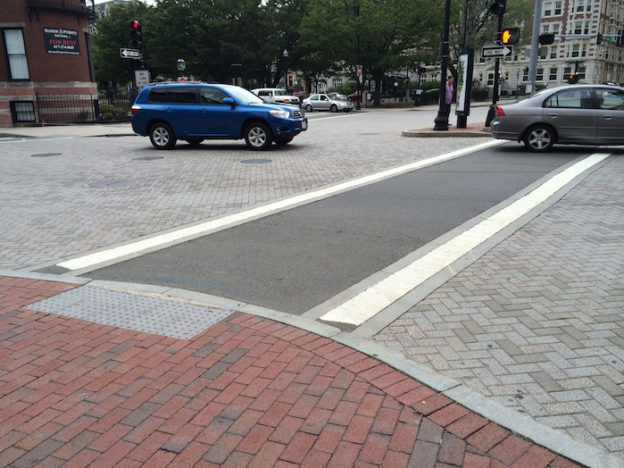I want to show you what a good job the City of Boston’s Public Works Department can do. I learned this several years ago when I was a member of a committee that worked to improve Cambridge Street. City employee Peter Scarpignato, now retired, was exceptional in judgment, sense of street design and safety awareness. We liked him for his wry, calm personality. When the new design was presented to the public, one neighbor who was inclined to be critical said, “This is the most beautiful plan I’ve ever seen.”
There must be more people like him in today’s Public Works Department because they are creating some beautiful spaces. Look at this curb at the intersection of Congress Street and Atlantic Avenue.
Notice the bricks, wire cut and scrupulously laid. See the contrasting gray, ADA-compliant tactile pad.
With this construction, the Public Works department saves time and money. The wire-cut bricks stay in place better than other bricks, and they provide a smoother surface for wheel chairs than concrete does, since concrete’s expansion joints can make for a bumpy ride.
Money? It’s interesting. Concrete tactile pads are one-third the cost of plastic ones and they last longer, according to the manufacturers. I don’t know if this is concrete or plastic, but I hope it is concrete. The plastic ones installed recently in the Back Bay are already losing their protruding circles.
So even though the wire-cut brick is more expensive, the total cost of using wire-cut brick/concrete instead of concrete/plastic pads is almost a wash. Since Public Works has installed so many of the handsomer kind, they must admire them.
Here is another of the city’s handsome solutions—this one on Newbury Street.
I want that on my street. Right now, after 40 years of poorly laid brick and no maintenance, my corner could use this kind of attention.
Take a look at this crossing in Kenmore Square.
This could be the work of the MBTA since it looks as if it was finished about the same time as the station, but most users couldn’t distinguish between the city’s work and that of the MBTA. The disabled community has praised this crossing for a treatment respectful of persons with any kind of ability. Moreover, it respects the history of Boston. And Kenmore Square isn’t even a historic district.
I don’t know what happened when this talented department decided to construct ramps on Beacon Hill. They put handsome ramps in non-historic districts, and then they suggested this to the Beacon Hill Architectural Commission instead.
Maybe the talented guys were at lunch and left it to an intern who grew up in Dubuque to create this plan. (Sorry, Dubuque.)
All I know is that this department is capable of good, sensitive work. If the Public Works Department submitted to the Beacon Hill Architectural Commission the solutions they have used elsewhere, including non-historic districts, everyone would be praising the them as the smartest department at City Hall. Mayor Walsh would accomplish his goal, which he outlined last week in Ireland, of how he wants to copy Ireland in its success as a community that remembers where it came from, preserves its culture, and markets its heritage and identity to a broad audience. The city wouldn’t have to waste money on a lawsuit that will ultimately preserve the authority of the Beacon Hill Architectural Commission. And the whole city would be both accessible and handsome from Hyde Park all the way through Sullivan Square. That’s what we all should want.




